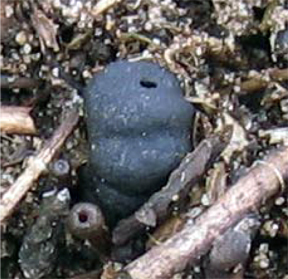Time to scout for mummy berry in blueberry fields
Editor’s note: This article is from the archives of the MSU Crop Advisory Team Alerts. Check the label of any pesticide referenced to ensure your use is included.
Now is the time of year to begin scouting for mummy berry. Mummy berry is a serious disease of high bush blueberries in Michigan and is prevalent in most blueberry-growing regions throughout the United States. The disease can kill young vegetative shoots, reducing next year’s yield potential. In addition, infected berries become tough and inedible. There is a zero tolerance for mummified berries in harvested fruit.
Mummified berries normally fall off the bush and overwinter on the ground. They germinate in spring to form apothecia, which resemble small brown trumpets. These “trumpets” shoot spores into the air that infect young shoots. The optimum temperature for formation of apothecia and infection is 50ºF to 57ºF (10ºC to 14ºC). Extended wet periods and frost promote infection as well. Infection can take place only when green leaf tissue is present. Therefore, if blueberries are at or past green tip, it is important to take a look on the ground below blueberry bushes to check for mummified berries and apothecia. Remember that they are brown to black which makes them blend in fairly well with the soil or dead leaves and may be hard to see. The presence of apothecia is a better predictor of disease than the presence of mummies per se.
Mummy berry apothecia were observed as early as April 14, 2009 in a blueberry field in Nunica, Michigan (Figure 1). This week some apothecia were also found in four other fields in Holland and Grand Junction, Michigan. The number of mummies on the ground varied between each scouted plot, from less than one to 16 mummies per bush. The percentage germination ranged from 0.3% to 15.8%, which is somewhat lower than in previous years. The germination rate is dependent on soil moisture, with wetter sites generally having higher germination rates. Germinated apothecia had cups of one to two mm in diameter. Apothecia with cups of two mm or larger will begin to release ascospores, which will lead to infection of newly developing shoots.
Growers should scout for mummy berry and consider fungicide treatment, if leaf buds are past green tip and mummies or apothecia are found. Early in the growing season, fungicides that are recommended for control of mummy berry are Indar, Orbit, Bravo, and Serenade. Indar and Orbit are systemic fungicides, which mean that they become rainfast within several hours of drying and have some post-infection activity. Bravo and Serenade are protectants, which remain on the plant surface and are subject to wash-off by rain. Serenade is a biofungicide containing bacteria that are antagonistic to the mummy berry fungus. Serenade is approved for organic production and should be applied with an adjuvant like NuFilm.



 Print
Print Email
Email



